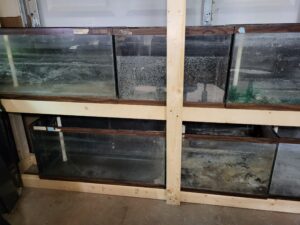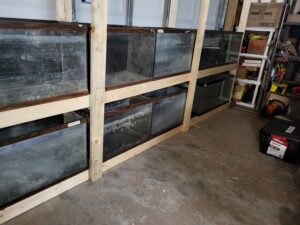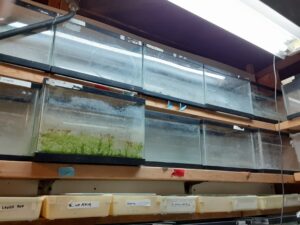
 Yesterday my friends Steve and Jessica came over to help build a rack for some of my many tanks not yet in use. They worked their butts off for some pizza.
Yesterday my friends Steve and Jessica came over to help build a rack for some of my many tanks not yet in use. They worked their butts off for some pizza.
We were able to construct a 16 foot section that holds 14 30-gallon and 20-Gallon High tanks. I expect to add another level to it that will add another 10 10-gallon tanks. I also added a section for my 2 /12 gallon tanks that holds 16 more tanks for raising fry. Forty-four tanks ain’t bad.
The next step will be to add a rack with 3 levels again. It should hold 8 more 20H tanks and a bunch of 5-gallon … roughly adding ten 5s for an additional 18 tanks. I will probably pause the construction there for awhile, but I have plenty of room to add more stands … I know insanity! It will mean I am running about 80 tanks before more construction and does not count the 1-gallon fry tanks at all.


 Join the forum discussion on this post
Join the forum discussion on this post This weekend is a planned construction day to complete most of my fish room. I need to build a couple of tank racks and install my aeration system to hook up my blower which should easily handle 100+ tanks. This will require some lengths of 2 inch PVP piping and a way to hang it. I have a few ideas from past experience to do it the best way instead of the worst.
This weekend is a planned construction day to complete most of my fish room. I need to build a couple of tank racks and install my aeration system to hook up my blower which should easily handle 100+ tanks. This will require some lengths of 2 inch PVP piping and a way to hang it. I have a few ideas from past experience to do it the best way instead of the worst.